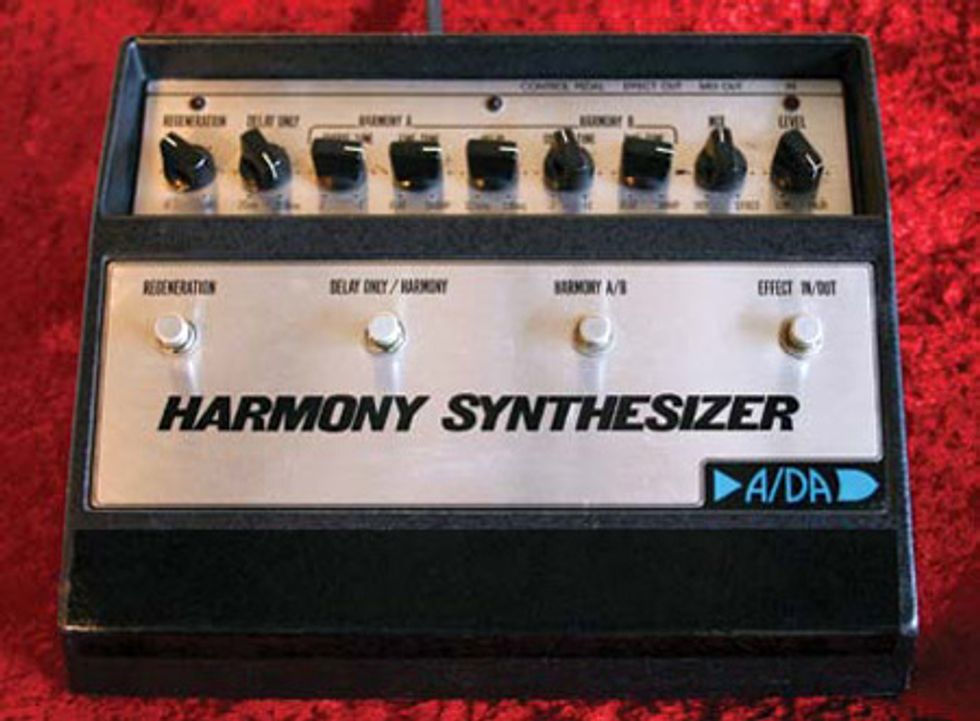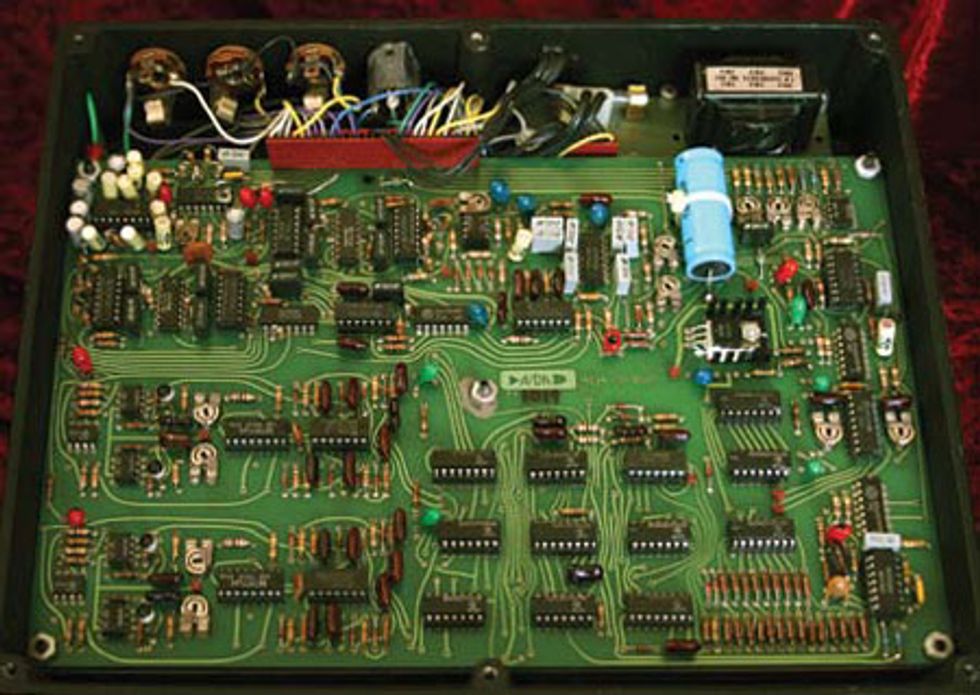
The A/DA Harmony Synthesizer features nine knobs and four
footswitches, plus 14 internal trimpots inside the case.
Greetings pedal people, and welcome back to “Stomp School.” We had a lot of fun with last month’s column, featuring a look inside a Ludwig Phase II Synthesizer repair, and we got some nice feedback on it as well. So I thought we would try something in a similar vein this month. Though we’re not documenting an actual repair this month, we will be discussing technical details and showing glorious full-color pedal pictures, including some close-up gut shots. So let’s get started with our in-depth view of yet another vintage behemoth from the ’70s—the A/DA Harmony Synthesizer.
Like the Ludwig Phase II, the A/DA Harmony Synthesizer is another “synthesizer” that isn’t, at least not in the literal sense. It doesn’t have its own built-in tone generator like a keyboard synth—it merely modifies the input signal of the player’s instrument. Designed by A/DA founder, David Tarnowski, the Harmony Synth is actually a rather elaborate analog delay and pitch transposer. The pitch transposing is accomplished without the use of digital technology by way of a painfully complex circuit that includes no less than 42 ICs (including two Reticon SAD1024A delay chips) and 14 internal trim-pots. At a size of 11 inches by 9 inches, it’s one of the larger vintage stomp-type effects, looking something like an overgrown A/DA Flanger.
Of course, an effect this complex increases the likelihood of something going wrong. I’ve received a few inquiries on the Harmony Synth over the past couple of months, two from collectors looking to have their broken units repaired. We weren’t quite prepared to take this on ourselves, and with no full schematic readily available it’s proven difficult to find an experienced technician willing to take up the challenge. Even Electro-Harmonix design engineer Howard “Mick” Davis was less than enthusiastic about the prospect. Regarding repair work, he told me, “Most EH products are welcome, but the A/DA Harmony Synth is a pretty hairy unit that is not on my preferred list.”
As far as I know (and I’ve researched it quite a bit), the A/DA Harmony Synth is the only harmonizer that uses 100 percent analog circuitry. I can’t stress the significance of this enough. It’s simply an amazing feat of analog circuit design. Even DIY effects guru Craig Anderton was impressed. In his 1979 review in Device magazine, he commented that from an engineer’s standpoint, “It’s amazing that this box even exists at all.” There’s no doubt that the A/DA Harmony Synthesizer is truly a bold, ambitious design.

A look at the Harmony Synth’s completely analog circuit board. It features 42 integrated
circuits, including two Reticon SAD1024A delay chips.
While most of today’s digital pitch-shifters operate with greater ease and fidelity, when the Harmony Synth arrived on the scene in ’79, there really wasn’t anything else quite like it. One unique feature was its ability to create polyphonic octave effects (the ability to play guitar chords on it), which wasn’t possible with the various octave dividers and multipliers that were then available. Of course, with pedals on the market like the Electro-Harmonix POG, this is something we now take for granted.
So, how does it sound? Well, it depends on what your expectations are. The sound quality is pretty lo-fi by anyone’s standards, especially when compared to something like an Eventide Harmonizer. Most people’s expectations are based on the digital pitch-shifting harmonizers that are currently available. The DigiTech Whammy set the benchmark in the early ’90s for what players expect in a pedal-based harmonizer. The average digital harmonizer typically allows the player to create specific harmonic intervals, perfectly in tune with the original note. Not so with the A/DA. The Harmony section offers only Coarse Tune and Fine Tune controls, leaving the player to tune the intervals by ear. And even after the desired interval is dialed in and tuned, the pitch is likely to drift.
Quirky and imperfect though it may be, I believe the A/DA Harmony Synthesizer can have some useful applications beyond bragging rights for vintage collectors. Anyone expecting digital perfection is missing the point. By the way, if you happen to know any brave and talented engineers, there are at least a couple of these units out there that are in need of repair. Until next time, keep on stompin’!
Tom Hughes
(a.k.a. Analog Tom) is the owner and proprietor of For Musicians Only (formusiciansonly.com) and author of Analog Man’s Guide to Vintage Effects. Questions or comments about this article can be sent to: stompschool@formusiciansonly.com.
Analog Man
(analogman.com) is one of the largest boutique effects manufacturers and retailers in the business, and it was established by “Analog” Mike Piera in 1993. Mike can be reached at AnalogMike@aol.com.







![Rig Rundown: Russian Circles’ Mike Sullivan [2025]](https://www.premierguitar.com/media-library/youtube.jpg?id=62303631&width=1245&height=700&quality=70&coordinates=0%2C0%2C0%2C0)

















